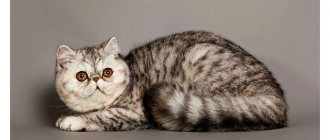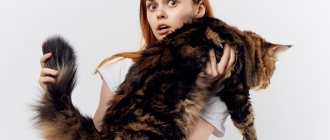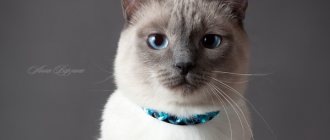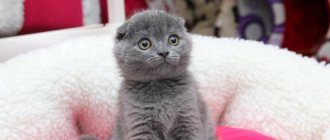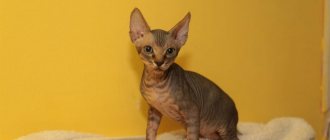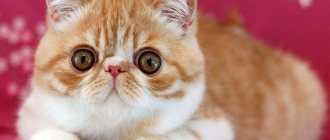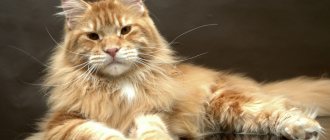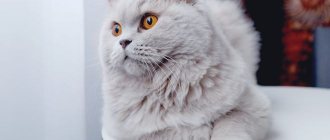The Japanese Bobtail is an unpredictable, inquisitive, active, sociable, explosive cat-disaster, capable of coloring the gray everyday life of its owner in all the colors of the rainbow. Yes, he is a restless fidget, but at the same time an excellent storyteller and psychologist.
The temperament and demeanor of these mustachioed “samurai” are completely original. It may take you years to study your pet’s psychotype, and it is likely that you will never be able to fully understand it. The Japanese are incredibly stubborn and at the same time incredibly smart. With such a furry friend, life will be difficult, but bright.
Origin story
The history of this breed goes back hundreds of years, and scientists still cannot say exactly where in the world these cats appeared. There is only an assumption that many centuries ago, clever mousecatchers arrived in Japan from China. However, initially their tails were the length familiar to those around them, and only much later, as a result of mixing of blood, did it shorten several times.
The superstitious Japanese only liked this change: they began not only to have bobtails in their homes, but also to depict them on canvas and sing them in poetry, and over time, these cats earned the highest imperial favor and ended up in the palace.
Bobtails were exported outside Japan only in 1967, when one of the breeders named Elizabeth Freret managed to buy and export three individuals to the American continent. A little later, several more animals were literally obtained through smuggling.
The standard was established in 1968, the same year the breed was registered with the CFA. But this only concerned individuals with short fur. Cats with a long “fur coat” were discarded for many years, until someone particularly meticulous, delving into ancient sources, found out that long-haired individuals were also kept at the emperor’s court and were valued no less than their counterparts. In 1990, they were also recognized.
Thinking about buying a Japanese Bobtail? You have a direct route to the nursery. Fortunately, it is in Russia: in the Moscow region, in the city of Zavidovo. On the territory of Belarus and Ukraine, alas, there are no nurseries or private breeders. The cost of an individual for a house from which there will be no offspring is approximately 30-40,000 rubles. Animals of a higher class will cost 2, 3 and even 4 times more expensive. But in Russia it is almost impossible to buy a show-class bobtail.
Purchasing a Japanese Bobtail kitten
In our country there are very few specialized nurseries for breeding Japanese bobtails, so it is difficult to buy a kitten of this breed. To be guaranteed to purchase a purebred baby, it is better to contact Japanese breeders directly.
Buying a Japanese Bobtail kitten is not easy
Criterias of choice
It is best to buy a small bobtail from a reliable nursery that has a good reputation. Sometimes private breeders also offer Japanese kittens. But such an acquisition can be risky, since visually a purebred kitten differs little from a simple mongrel baby with a congenitally underdeveloped tail. The price of a purebred Japanese bobtail starts from 30 thousand rubles and depends on the sex of the animal, its color and breed characteristics (class). Individuals with a predominant white coat and multi-colored eyes (golden and blue) are especially valued.
It is recommended to buy Japanese Bobtail kittens from specialized nurseries.
Too low a price should be a concern. Almost certainly the owner is trying to sell the outbred baby, passing it off as a Japanese bobtail.
In a litter of cats of this breed, all kittens are born with short tails, so it is advised to look not only at the parents, but also at the other kittens before purchasing. A pedigree indicating the exterior characteristics of the last four generations is required. It is advisable to have all the vaccinations required for this age. Especially if the pet needs to be transported over a long distance.
When purchasing, pay attention to the following points:
- the baby should be very active, mobile and inquisitive;
- healthy appearance, soft and shiny coat;
- The eyes are clear, the ears are clean (without any discharge).
The kitten should look healthy and active
At what age is it better to adopt a kitten?
Japanese cats have kittens that are slightly larger than most other breeds. They begin to climb out of the box extremely early and become independent faster. They are given away only after 3-4 months, because at this age you can already determine the exterior of the future champion.
Japanese Bobtail kittens are given away after three months
Standards
| Standard | Description |
| Scull | Triangular, with clearly defined cheekbones and plump whisker pads on a funny oriental muzzle. |
| Nose | Medium length, with a pronounced “stop” on the bridge of the nose. |
| Eyes | Large, oval, wide open, set slightly askew. The color of the iris can be any. |
| Ears | Large and erect, densely pubescent on the inside. Small tassels may grow on the tips. |
| Torso | The body is long and rectangular. The muscles are visible, the general impression is that the cat is “lean”, gracefully built. The limbs are slender, long (the forelimbs are noticeably shorter than the hind limbs), arranged in the shape of the letter Z. The paws are oval and elastic. |
| Tail | Set high and curled into a ball. Its length in the straightened state is no more than 8 cm. The tails are conventionally divided into spiral and chrysanthemum-shaped. |
| Wool | The coat is thick and neat. Both short-haired and long-haired cats have very soft hair with no undercoat. In the area of the hind legs it grows thicker and more abundantly, forming lush pantaloons. |
Disqualifying signs:
- Strongly built body.
- Oval or round skull shape.
- A long tail.
- Small ears.
- Button nose.
Features of large eyes
The location and size of the eyes depend on the breed of the pet. Some cats have such unusual and beautiful eyes that their gaze is simply mesmerizing. Looking at them, you get the impression that you are communicating with a representative of another civilization. The expression “eyes are the mirror of the soul” applies to such cats in the most direct way.
Snow-white beauty
Experts assure that, regardless of the shape and size of their eyes, cats do not have three-dimensional vision and perceive their surroundings differently from humans. In addition, due to severe farsightedness, some pets may not even be able to discern what is going on under their noses.
Conventionally, the shape of cats' eyes is classified into 3 types:
- round;
- almond-shaped;
- slanted.
Breeds with the first two types boast large and expressive eyes. Cats with slanted eyes look more unusual and alien-like.
Attention! If you want to have a pet with a certain iris color, you should pay attention to the color of the kitten’s coat, which directly affects the color of the eyes.
Character and behavior
The Japanese Bobtail is a real little devil, whose unpredictability will not let you get bored for a single minute. On the one hand, he is a very affectionate and gentle domestic baby, a strong little one, who becomes attached to his owner with all his soul, on the other hand, he is an extremely independent and irrepressible cat-chieftain, who will not sit still for a second. Moreover, age has absolutely no effect on it: as a baby, as a teenager, as a mature cat, a bobtail will still jump, run and climb into all the nooks and crannies of the house, check packages and open closed drawers, poke its curious nose into pots and plates.
He can also sit next to his owner’s warm side, but for about five minutes, no more, and then he will return to his daily business - mischief and running around.
This is one of the most talkative breeds. He will tell you how bored he was while you were away, what he ate today, what bird he saw outside the window, or what a strange dream he had at night. You don’t have to answer him at all - the main thing for a bobtail is that they listen to him sincerely, and the rest worries him little. Therefore, weigh the pros and cons of this breed in advance.
The Japanese Bobtail has a great time with itself, so you can safely go to work or wherever you want. He will not refuse food during your absence or lie melancholy near the door; on the contrary, he will find a dozen interesting things to do and will be busy until your arrival.
Gets along well with other pets, and this applies to both dogs and other cats. Jealousy is alien to the bobtail, on the contrary: he will quickly be able to “talk” the second cat into joint pranks and become his best friend.
An intelligent and quick-witted bobtail grasps new information “on the fly” and lends itself well to training. Of course, only if he himself wants to learn something new. For example, doing a stand on your hind legs, or catching a foil ball on the fly. Walking on a leash can also be considered a trick - bobtails really don’t like it when their freedom is limited in any way. However, he needs to be leash trained if you want to take him outdoors.
Are a cat's pupils the same during the day and at night?
Not really
Health
The average life expectancy varies from 13 to 15 years, but long-livers of 20 years of age are not uncommon.
This breed is considered generally healthy, with only occasional skeletal defects in kittens. The short tail of the Japanese Bobtail is a genetic mutation, but does not carry with it any other defects or mutations.
One of the characteristics of kittens is their different eye colors, namely one is blue and the other is yellow. This is mainly characteristic of individuals with white coat color. Such a kitten is more likely to be deaf.
Care instructions
Japanese Bobtails are very clean themselves. They clean their skin several times a day, so not much effort is required from the owner.
Wool
Bobtails have minimal undercoat, so frequent brushing is not necessary. Once a week is enough. Bobtails' fur does not tangle or roll into tangles, the shedding process goes unnoticed, but the fur still requires careful handling and a special brush - with natural soft bristles.
Bathing
The process of bathing gives bobtails pleasure, and they are ready to get into a full bath at the first opportunity, but you should not indulge this desire. Frequent washing provokes irritation and dryness of the skin, rashes and peeling. Bathe your cat once every 4-5 months (and, of course, if he is so dirty that he cannot lick himself).
Choose special shampoos, without PVA, dyes and fragrances. The detergents Doctor ZOO, Pchelodar, Celandine, and “Deep Cleaning” from Cliny have proven themselves well: they are affordable, contain antibacterial additives, collagen and plant extracts.
Eyes
Dry eyes in bobtails are not the norm, but a signal of problems in the body, so do not delay going to the veterinary clinic. But discharge in the ears is not a sign of concern. Earwax should be removed weekly using a soft cotton swab dipped in boiled water or a special ear lotion.
Claws
Bobtails sharpen their claws themselves; all you need to do is buy several scratching posts and place them in all rooms. This will protect your decor from marks on the walls and furniture.
Teeth
Brushing your teeth is often difficult. A bobtail, due to its stubbornness, can begin to struggle and even hiss, which, however, is not even surprising: who would like it when they climb into his mouth with a hard brush and crawl back and forth? Therefore, try to accustom your pet to this procedure while still a kitten.
As a last resort, you can take your cat to the clinic for ultrasonic cleaning every year, and at home, drip a special cleansing gel into his water.
Toilet
Most often, it is not you who choose the litter for the tray, but your cat: if he is uncomfortable, he will definitely let you know. Keep in mind that for animals with sensitive paws, small round granules are needed, and for large cats you can buy larger ones (they will not get stuck between the toes or stick to the fur).
Buy only natural litter for kittens: babies can play too much and swallow several granules, which can cause stomach problems.
Reasons for the uniformity of selection
In Japan, representatives of the cat world enjoy such respect, honor and exclusive rights that they cannot count on in any other country in the world. This special attitude towards cats is caused by culture and religious and ritual traditions passed down over many centuries.
According to local beliefs, the tail of any animal is a concentration of devilish energy, negativity and destruction. This was the reason that cats with long tails were not particularly popular, while representatives with short tails became inhabitants of the imperial palace. The rest of the cats were destined for a terrible fate: their furry source of pride was simply chopped off by people who wanted to limit themselves from negativity.
It was here that kittens without this organ began to be born. It is possible that such mutations in cats occurred everywhere, but only Japanese residents reacted with enthusiasm to this fact and began to take especially careful care of tailless animals, which was the beginning of narrowly targeted selection.
The trait quickly took hold and became the main anatomical feature cultivated in Japan. Since the country remained closed for a long time, the new standards did not make any changes, and the breed became increasingly established and rooted during crossings between similar specimens. The species is called the Japanese Bobtail.
Catering
Japanese Bobtails do not need to prepare special dishes: the standard cat menu is quite suitable. Moreover, experienced breeders recommend natural nutrition. What does it include?
Natural products
- Lean meats: lamb, chicken, turkey, veal, beef. Pork and other fatty varieties are too heavy on the stomach and often contain parasites. Meat can be given boiled, but it is better to scald fresh meat with boiling water and cut into small pieces: this way, more nutrients will be retained in the product.
- By-products: necks, ventricles, kidneys, liver. Everything except liver can be given raw. Be sure to beat the chicken necks with a hammer and run through a meat grinder.
- Porridge: oatmeal, pearl barley, buckwheat, semolina, rice, millet. Porridge is cooked in water; you can add just a little milk (for taste). Kittens at 2-3 months can be supplemented with semolina porridge cooked in goat's milk with a drop of honey.
- Vegetables: pumpkin, zucchini, carrots, broccoli, green salad, green peas, white cabbage, parsley, dill, cucumbers. They can be given raw (although rarely do cats like to eat raw vegetables), but it is better to be stewed and boiled.
- Dairy products: curdled milk, cream, sour cream, cottage cheese, cheese (unsalted and hard), fermented baked milk, bio-yogurt without dyes and berries.
- Eggs: quail and chicken. Quail can be given whole, but from chicken - only the yolk.
- Fish and seafood. Fish of the salmon family (chum salmon, pink salmon, coho salmon, salmon, taimen, grayling, gole, omul, whitefish) are considered the most healthy. From seafood, rapana, squid, mussels, lobsters, lobsters, shrimp, crabs, crayfish are allowed - but only as a delicacy. All of the above is either frozen or boiled.
- Vitamins: your veterinarian will help you choose the appropriate complex. You can buy dry yeast yourself (the instructions are included in the package and are clear).
You cannot give:
- Bones. Even small and boiled ones can damage the throat, esophagus and stomach, pierce or scratch the mucous membrane and cause inflammation.
- Offal, lard, skin.
- Sweet, salty, smoked, pickled, sour, flour, baked goods.
- Potatoes, tomatoes, avocados, grapes, bananas.
- Sauces, pastes, mayonnaise, seasonings.
- Food for dogs and birds, human vitamins.
- Alcoholic drinks, mineral and carbonated water, juices, fruit drinks, cocktails.
Recommended food
If it is more convenient for you to feed your pet industrial food, choose only proven food from the holistic group. They are not cheap, but they are made from high-quality products, go through all the necessary processing and do not contain components that can negatively affect the cat's health.
Acana, Go Natural, Primordial are examples of good holistic foods. Super-premium foods may contain allergens such as cornmeal or potatoes, but overall they are a good alternative. This food is Guabi Natural, Meowing Heads, ProSeries.
Below are the recommended holistic and super-premium foods. Links with the names of the food are clickable, on them you can, within our website, get acquainted with the descriptions of the food and read reviews from owners of Japanese Bobtail cats.
| Holistic | Super premium | Super premium |
| Farmina N&D | Brit Care | Natyka |
Adult animals (over a year old) eat 2 times a day. An exception is made for pregnant and lactating cats - they are fed 3 times a day. Cats from six months to a year eat 3 times a day, at 4-6 months - 4 times, under 4 - 5-6 times.
Expert opinion
Dusheba Vera Ivanovna
In 2010, she graduated from the Moscow State Academy of Veterinary Medicine named after K.I. Scriabin with honors, specializing in veterinary medicine. I regularly attend veterinary conferences, congresses, and webinars.
Whatever the food - dry food or natural food - the animal must have access to clean drinking water at any time of the day. You should not give your cat boiled water; it is better to give it raw, but always purified. Purify the liquid using a filter (the usual one that is in your kitchen), settling (in a saucepan or jar without a lid for 10-12 hours) or buying bottled water in the store. Change the water 2 times a day: morning and evening, and also when dirty.
Bowls are washed after each meal - this applies to natural feeding. Dry food does not stain dishes as much, so it is enough to rinse them 3-4 times a week.
Features of vision in cats with huge eyes
The special structure of the eye makes cats with huge eyes stand out among other predatory mammals. Big-eyed cat breeds are the peak of perfection. Thanks to their huge visual organ, they have a visual angle of 170-185 degrees, when in cats with normal eyes this angle is 160-169 degrees, but this is not small! In dogs, the field of vision is almost 2 times smaller.
The cutest big-eyed cats
Thanks to selection and random mutations, cats with big eyes exist not only in cartoons, but also in the real world. Many cats can boast an expressive look, but only some representatives of the whiskers have truly huge eyes. We invite you to meet the most big-eyed cats on the planet who have conquered the Internet:
- 1 place.
Cobby The black sheep of the cat world - this is how one can characterize the British Shorthaired Chinchilla. All representatives of the breed have a bluish-gray coat color, but Cobby is special. Snow-white fur combines effectively with huge sky-blue eyes. The black edging around the eyes gives incredible expressiveness to the look. Cobby has his own page on Facebook and Instagram. - 2nd place.
Gimo A rising Instagram star who is often compared to the Cheshire cat. Indeed, these cats have a lot in common! No matter what this cute cat with big eyes does, it is impossible to resist his hypnotic gaze of yellow eyes. Today Gimo has more than 160 thousand subscribers.
- 3rd place.
Snoopy Short-haired exotic cat Snoopy, one of the cutest cats with huge eyes. Snoopy is one of the most popular felines, with over a million subscribers! An innocent and even a little wise look perfectly complements the natural sense of smell. Many people who are poorly versed in felinology call representatives of short-haired exotics the “Snuppy breed.” - 4th place.
Cat Herman A very unusual big-eyed cat. Cat lovers have been arguing about Herman's mercy for a long time. Someone writes: “A cat like this can only scare people at night,” others believe that the cat is constantly surprised and frightened, while others dream of having such a pet nearby. Looking at Herman’s photos on Instagram, it’s hard to argue that he is unique. The cat has a distinct personality. His channel has more than 21.1 thousand subscribers.
Diseases
Since this is a native breed, no genetic pathologies have been identified in them. There are no claims to immunity either.
The only caveat: due to the lack of undercoat, bobtails easily catch colds. Therefore, make sure that there are no drafts in the apartment, let the cat dry thoroughly after water treatments, and also, do not allow the animal, hot after playing, to sit under the open window.
Everything else is standard. Helminths need to be driven out even if your cat does not go outside. These parasitic worms can live not only in the soil or other people's excrement, but also remain on raw meat, fish, and you can bring them into the house on your own hands or shoes. They are easy for humans to become infected with, so remember: Pirantel, Kanikvantel, Troncil K, Prazitel have proven themselves well in the pharmaceutical market. They can be given to a kitten from 3 months. A year - 4 times, if the cat stays at home, more often for street cats. After 2 weeks, cats can be vaccinated.
Expert opinion
Dusheba Vera Ivanovna
In 2010, she graduated from the Moscow State Academy of Veterinary Medicine named after K.I. Scriabin with honors, specializing in veterinary medicine. I regularly attend veterinary conferences, congresses, and webinars.
Cats nursing babies, as well as pregnant cats, should not be given medications! You should be more careful with cats that are elderly, weakened after illness, or exhausted. To be sure that you do not harm your pet, consult your doctor first. The veterinarian will examine the animal, take the necessary tests, and possibly prescribe additional tests.
Interesting Facts
Close relatives of Japanese bobtails live in the Kuril Islands, in the area of Iturup and Sakhalin. Only their popularity increased in the 90s. last century. Cats from this area belong to the Kurilian Bobtail breed.
They have long hair and also a strange tail shape. A fur coat of wool reliably protects from the cold, and on the front paws there are even downy “pants” that cats inherited from their Siberian ancestors.
Advantages and disadvantages
- Beautiful in appearance.
- Loyal to their owners.
- They are smart and quickly grasp new information.
- They do not require complex care.
- They love to swim.
- They practically do not shed.
- They respond well to training.
- They have excellent health and no genetic diseases.
- They live long.
- They quickly get used to their new place of residence.
- They love walks in nature.
- Their tail is a point of increased attention.
- Activity can be tiring for those around you.
- They can be extremely stubborn and persistent.
- Excessive curiosity can lead to disaster.
- They are sensitive to temperature changes and freeze easily.
Scottish Fold (Scottish Fold)
The Scottish Fold cat is famous for its unusual folded ears and bright yellowish-orange eyes. These cute creatures have a calm nature, love to be around people and can get along with anyone.
Although Scottish Folds have gained popularity for their funny ears, their large, beautiful, round-shaped eyes have not gone unnoticed. The irises of these cats are colored in shades of gold, blue and green. Add fluffy ears to such eyes and you will get the cutest representative of the cat family!
As active mousecatchers, Scottish Folds are playful, sensitive and expressive. These cheerful cats have a habit of taking strange poses: sitting upright, like meerkats, lying flat on the floor or on their backs with their paws raised up. They are moderately active, choosing toys to train dexterity and intelligence, such as puzzles. These animals need communication and make good companions.
If you have a Scottish Fold, be prepared to play with it after you get home from school or work.
California radiant
When creating the breed, the breeders set a goal to breed a pet similar to a leopard. By crossing Abyssinians, Siamese, British and American Shorthairs, Paul Casey sought to demonstrate the problem of big cat conservation.
The California cat's slanted eyes stand out on its wild face and are usually copper or amber in color. The animal has an athletic build, long legs and smooth fur.
Representatives of this breed are suitable for living in a family; they prefer to be at the center of family life, expressing their love and attention.
Based on materials from thediscerningcat.com
Ragamuffin
Despite their large and long body, Ragamuffins are very cute, thanks in part to their large, charming eyes. Their fur is quite fluffy and can reach a considerable length. These pets are distinguished by their obedience, as well as their desire to spend time in the arms of their owner.
Ragamuffins' actions during childhood are more reminiscent of puppies than kittens. Young representatives of the breed love to play fetch (“fetch an object”), learn new tricks, and even go for walks. However, they are very domestic cats and prefer to be with their family.
British Shorthair
British cats range in size from medium to large. These animals have large gold, orange or copper-colored eyes and a short, wide nose. Their short or medium-length coat requires constant care, especially during the shedding period.
These cute creatures are intellectually developed and prefer to spend time at home with toys and people. The gentle nature of the animal allows it to get along well with its owner. Although British Shorthairs love to play, they do not require constant human attention.
Top 10 big-eyed breeds or the most “soulful” cats
Remember the cartoon about Snoopy? This character is beloved by both children and adults. A velvety prankster with huge sweet eyes who loves hugs. The prototype of the multi-hero was a cat of a real existing breed - exotic shorthair. Although the huge bottomless eyes of “Snoopy” are not considered the largest in the world. Perhaps because the animals themselves are small.
So who then are these mysterious creatures with a wide soul? After all, according to a popular expression, the soul should be wider, the larger the size of the eyes? Here are eight of the biggest big-eyed four-legged creatures known to man.
